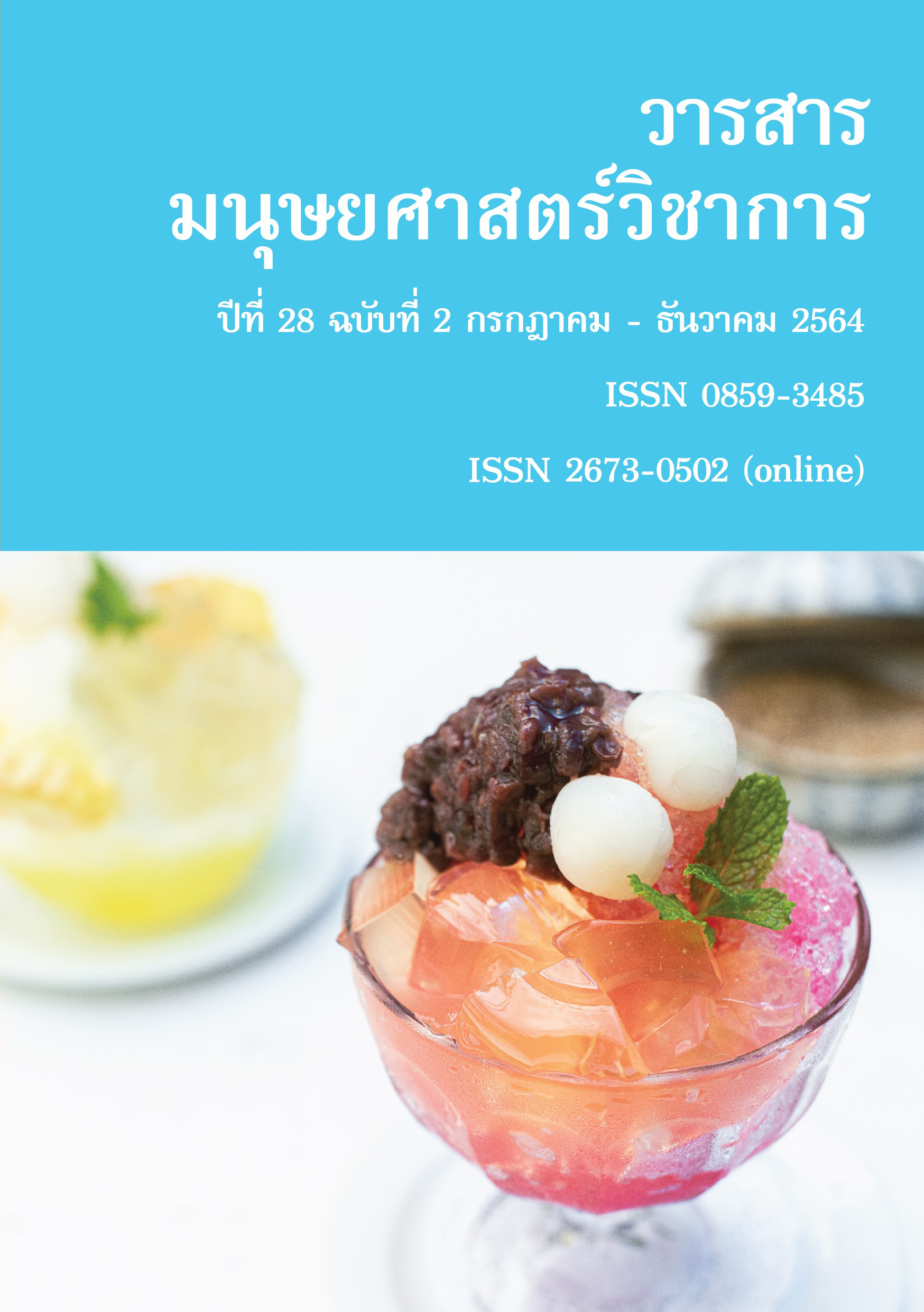The implementation of Active Learning in an Advanced Japanese Reading Class
Main Article Content
Abstract
The objective of this research was to study student’s satisfaction towards an implementation of active learning in advanced Japanese reading class. The results found that, regarding the classroom activities, overall the students were most satisfied with active learning instructional model. Especially, students thought that active learning one, helped them develop their thinking skills, communication skills and collaboration skills. Second, promoted them to use various skills such as listening, speaking, reading, writing including thinking skills. Three, encouraged students to participate in the classroom activities. Finally, fourth, trained students to accept the opinions of the others. Regarding the teacher characteristics, the study found that students were most agreed on all issues. Especially, they gave full points for teacher’s knowledge, teaching ability and preparedness for teaching. Regarding the achievement of learning outcomes in 5 domain of TQF (Thai Qualifications Framework), the study found that students thought that they achieved 5 domain of learning outcomes. The results of the study can be concluded that the implementation of active learning in a Japanese reading class achieved five domain of learning outcomes of TQF. The students were enthusiastic, accepted and supported the instructional model.
Article Details
References
กนกวรรณ เลาหบูรณะกิจ คะตะกิริ. (2561). การเรียนการสอนภาษาญี่ปุ่นเพื่อพัฒนาการเรียนรู้แบบตื่นตัวและไตร่ตรอง. วารสารอักษรศาสตร์. 47(2), 331-391.
ทัศนีย์ เมธาพิสิฐ และ ยูมิโกะ ยามาโมโตะ. (2558). การพัฒนาบุคลากรให้มีศักยภาพการทำงานในระดับสากล: กรณีการเตรียมความพร้อมสำหรับฝึกงานในต่างประเทศ. วารสารเครือข่ายญี่ปุ่นศึกษา. 7(2), 83-100.
นนทลี พรธาดาวิทย์. (2559). การจัดการเรียนรู้แบบ Active Learning. กรุงเทพฯ: ทริปเพิ้ล เอ็ดดูเคชั่น.
นนทลี พรธาดาวิทย์. 2560. การพัฒนาการจัดการเรียนรู้เชิงรุกในวิชาการจัดการเรียนรู้. วารสารวิจัยราชมงคลกรุงเทพ. 11(1), 85-94.
นะโอะโกะ โยะฌิดะ และ ทนพร ตรีรัตน์สกุลชัย. (2559). การศึกษาผลสัมฤทธิ์ทางการเรียนต่อการสอนแบบแบบห้องเรียนกลับทาง รายวิชาภาษาญี่ปุ่นพื้นฐาน 1 ของนักศึกษาที่ไม่ใช่วิชาเอกภาษาญี่ปุ่น มหาวิทยาลัย เชียงใหม่. วารสารเครือข่ายญี่ปุ่นศึกษา. 6(2), 71-83.
บุญชม ศรีสะอาด. (2539). การแปลผลเมื่อใช้เครื่องมือรวบรวมข้อมูลแบบมาตราส่วนประมาณค่า. วารสารการวัดผลการศึกษามหาวิทยาลัยมหาสารคาม, 2(1), 64-70.
พรทิพย์ วงศ์ไพบูลย์. (2560). การเรียนรู้เชิงรุกและการมีส่วนร่วมของผู้เรียน (Active Learning). วารสารสถาบันวิจัยญาณสังวร. 8(2), 327-336.
พันธ์ศักดิ์ พลสารัมย์. (2546). การปฏิรูปการเรียนการสอนระดับอุดมศึกษา: การพัฒนากระบวนการเรียนรู้ในระดับปริญญาตรี. วารสารเซนต์จอห์น. 6(6), 1-15.
พิมพันธ์ เดชะคุปต์ และ พเยาว์ ยินดีสุข. (2561). การเรียนรู้เชิงรุกแบบรวมพลังกับ PLC เพื่อการพัฒนา. กรุงเทพฯ: โรงพิมพ์แห่งจุฬาลงกรณ์มหาวิทยาลัย.
ยุพกา ฟูกุชิม่า. (2562). ทัศนคติของผู้เรียนต่อการบรรยายด้วยภาษาญี่ปุ่นของผู้สอนชาวไทยในรายวิชาการอ่านภาษาญี่ปุ่นขั้นสูง. วารสารเครือข่ายญี่ปุ่นศึกษา. 9(1), 25-48.
ยุพกา ฟูกุชิม่า และ ริกะ อินะงะขิ. (2562). ความเชื่อ และความคาดหวังของผู้เรียนภาษาญี่ปุ่นชาวไทยต่อชั้นเรียนภาษาญี่ปุ่น ครูภาษาญี่ปุ่น และบทบาทของผู้สอน. วารสารเครือข่ายญี่ปุ่นศึกษา. 9(2), 1-25.
ราชบัณฑิตยสถาน. 2557. พจนานุกรมศัพท์ภาษาศาสตร์ (ภาษาศาสตร์ประยุกต์) ฉบับราชบัณฑิตยสถาน พิมพ์ครั้งที่ 2. กรุงเทพฯ: ราชบัณฑิตยสถาน.
วิชัย วงษ์ใหญ่ และ มารุต พัฒพล. (2562). การประเมินตามสภาพจริงอิงสมรรถนะ. กรุงเทพฯ: ศูนย์ผู้นำนวัตกรรมหลักสูตรและการเรียนรู้. สืบค้นเมื่อ 16 มกราคม2563 จาก http://www.curriculumandlearning.com
ศิริวรรณ มุนินทรวงศ์ และ ทัศนีย์ เมธาพิสิฐ. (2558). ทิศทางการพัฒนาทรัพยากรบุคคลเพื่อผู้ประกอบการญี่ปุ่นในไทยในศตวรรษที่ 21. วารสารเครือข่ายญี่ปุ่นศึกษา. 5(2), 48-69.
ศิริวรรณ มุนินทรวงศ์. (2561). ปัญหาการฝึกงานและทักษะในการทำงานของนักศึกษาสาขาวิชาภาษาญี่ปุ่น มหาวิทยาลัยธรรมศาสตร์. วารสารเครือข่ายญี่ปุ่นศึกษา. ฉบับพิเศษ 8(3), 206-218.
สถาพร พฤฑฒิกุล.(2555). คุณภาพผู้เรียน...เกิดจากกระบวนการเรียนรู้. วารสารบริหารการศึกษา มหาวิทยาลัยบูรพา. 6(2), 1-13.
สุณีย์รัตน์ เนียรเจริญสุข. (2561). ประสิทธิผลของกิจกรรมการอ่านร่วมกันกับเพื่อนในวิชาการอ่านภาษาญี่ปุ่น. วารสารญี่ปุ่นศึกษา. 35(2), 64-77.
Bonwell, C.C., & Eison, J. A. (1991). Active Learning: Creating Excitement in the Classroom. Retrieved from https://files.eric.ed.gov/fulltext/ED336049.pdf
Dale, E. (1969). Audio-Visual Methods in Teaching, 3rd ed., New York: Holt, Rinehart & Winston.
Fujita, Y. (2014). Nihongo jookyuu gakushuusha no jiritsusei o takameru tame no jugyoo katsudoo no kooka to kadai. Obirin Forum of Language Education, 10, 103-118. (in Japanese)
Ikeda, R. & Tateoka, Y. (2007). An Introduction to Peer Reading. Tokyo: Hituzi Shobo Publishing. (in Japanese)
Ishiguro, K. (2012). Dokkai to sono oshiekata o kangaeru. Japanese Language Education Bulletin Japan Foundation Bangkok, 9, 1-18. (in Japanese)
Iwashita, M. (2013). Studies in Reading Comprehension Peer-Learning Activities: Using The Restaurant of Many Orders by Kenji Miyazawa. The Kwassui review. Department of Contemporary Japanese Culture, 56, 68-48. (in Japanese)
Kaewkritsadang, P. (2017). Can-Do Statements Based Japanese Language Education: Study for Application to Create New Curriculum and Japanese Language Textbooks for Undergraduate Students in Thailand. Journal for Japanese studies, 7, 111-128. (in Japanese)
Kouda, Y. & Ishii, Y. (2012). Research on Incorporating Active Reading into Traditional Intensive Reading class: Aiming at Non-task Activity. 2012 WEB Ver. Report of Practical Research Forum for Japanese Education, 1-10. (in Japanese)
McKinney, K. & Heyl, B. S. (2008). Sociology through Active Learning: Student Exercises. California: Pine Forge Press.
Mori, T. (2015). Gakushuu kagaku ga egaku 21 seikigata jugyoo no dezain. Gakushuu shisutemu kenkyuu, the first issue, 60-70. (in Japanese)
Taniguchi, S. (1991). Thinking-aloud in the Reading Classroom: Observation of Learner Strategies. Journal of Japanese Language Teaching, 75, 37-50. (in Japanese)
Tateoka, Y. (2005). From Reading alone to Peer Reading. Kanagawa: Tokai University Press. (in Japanese)
Tateoka, Y. (2006). Dokkai jugyoo ni okeru kyooshi shudoo to kyoodooteki gakushuu: 2 tsu no apuroochi kara kyoodoo no kyooshitsu dezain o kangaeru. Bulletin of the Foreign Student Education Center, Tokai University, 26, 33-48. (in Japanese)
Tsuji, K., Mochizuki, S., Shindo, M., Sato, A. (2016). Is “Non-Teaching Class” Effective?: Considering Evaluation Methods for Student-Centered Classroom Activities. 2016 WEB Ver. Report of Practical Research Forum for Japanese Education, 1-10. (in Japanese)
Umemura, O. (2003). Nihongo kyooiku ni okeru dokkai shidoo: extensive reading no kokoromi. Journal of international students education, 8, 173-182. (in Japanese)


